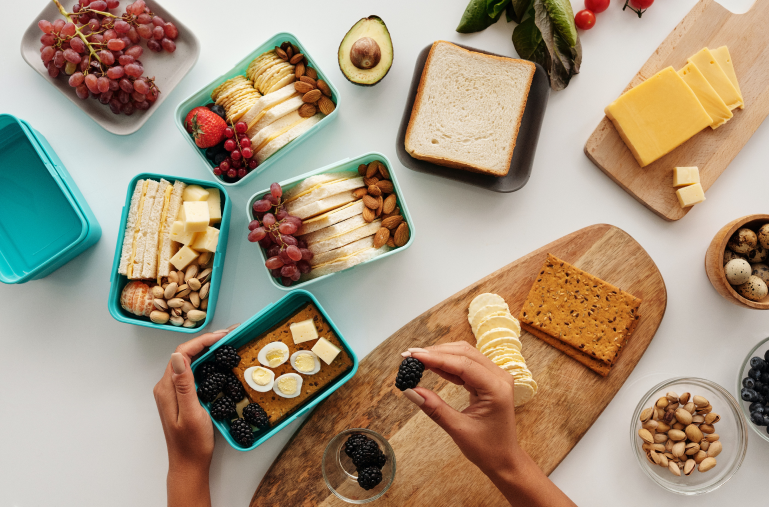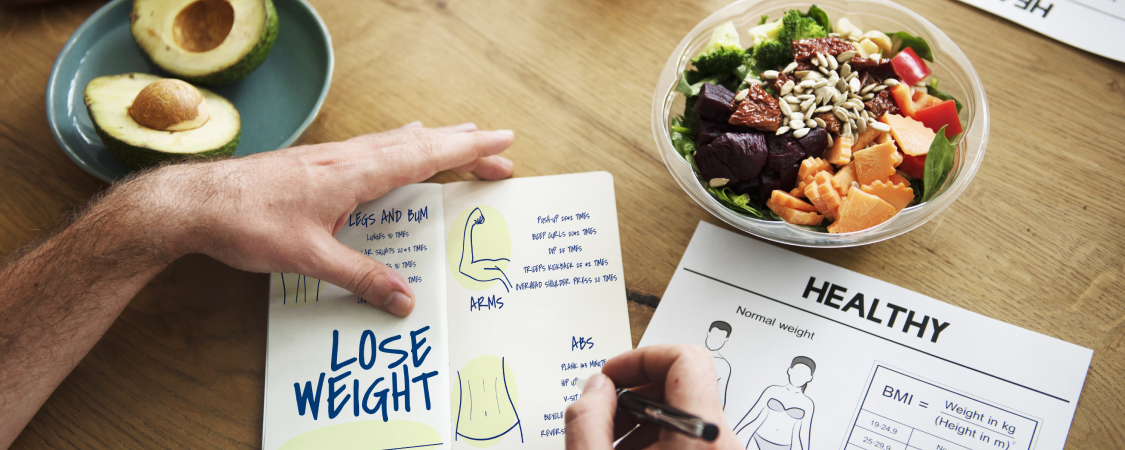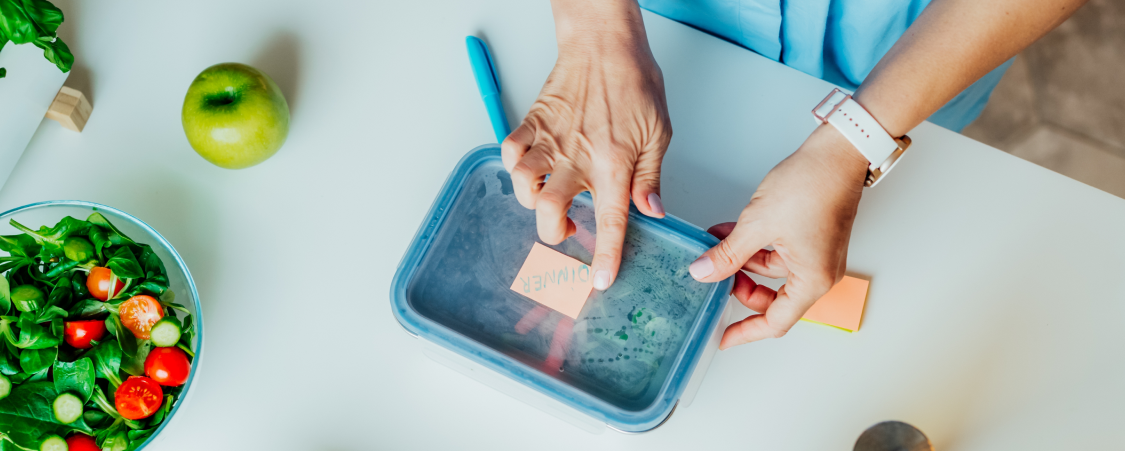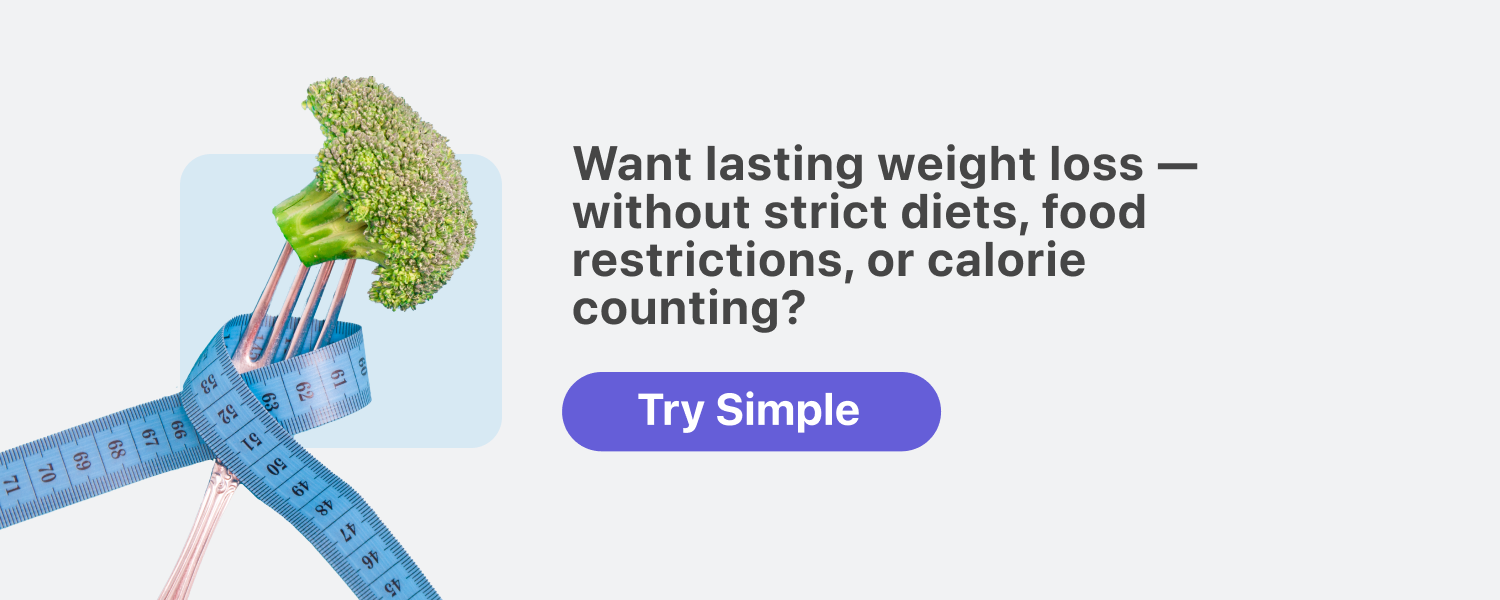How to meal plan like a pro — explained by Simple’s experts

Juggling work, family, social commitments, and “you” time can be overwhelming — not to mention draining and expensive. What if we told you that, whatever your current schedule, routine, or lifestyle, we can help you save energy, time, and money?
By learning how to meal plan, you can not only save yourself hassle and free up more of your weekly budget but also reduce food waste and eat more delicious, nutrient-rich food that will fuel your body to be the superhuman you are.

We know the thought of yet another thing to “plan” sounds daunting, but it’s actually a lot easier than you may think, and we’re here to help. We’ve gotten our experts to create your super simple, step-by-step guide to what meal planning is, how it can help you, why you should try it, and, most importantly, tips for recipes and grocery shopping so you can become a meal planning pro.
What is meal planning?

Meal planning is the intentional process of building a weekly, bi-weekly, or monthly menu that factors in your and your family’s schedules, preferences, budgets, and nutritional needs.
It may involve advance planning, but it’s not about following a specific meal plan. Meal plans can involve static, paint-by-numbers templates about what and when you should eat. Think weight loss plans, personal training plans, or fasting-based plans like 12-hour intermittent fasting, 14:10 intermittent fasting, or 16:8 intermittent fasting.
Sounds like a lot of structure.
On the other hand, meal planning offers plenty of wiggle room.
Making a meal plan is simply creating a strategy around what meals you’re going to eat and writing down what ingredients you’re going to need for them before you go grocery shopping.
Sure, it could factor in specific nutritional goals, but it’s also built with the intention of fitting in with the rest of your life rather than constructing your life around your meals.
The level of planning involved can also vary. Many people learn how to make a meal plan on a weekly basis since fresh veggies, fruits, meats, and other products may not have a long shelf life, but whether your preference and capacity for advance planning includes a few days or a few weeks, meal planning can work for you.
The bottom line is that it’s a much more customizable and personalized way of developing ideas for meals that accommodate your and your family’s individual needs.(By the way, if you’re looking for some help to track those meals you’ve worked so hard to plan, why not take our Simple quiz? Our food tracker will help you stay accountable, and if you’re into intermittent fasting, we’ll get you up and running with that, too.)
So, why meal plan?
Picture it: you’ve had an incredibly long day.
Work was so manic that you only had time to run to the nearest fast food joint for a quick lunch to tide you over.
Now you’re tired, you’re starving, your thoughts are whirling, and all you want to do is unwind over a good dinner.
So you open the fridge … only to realize you don’t know what’s for dinner. The last thing you feel like doing right now is trying to figure it out. Or worse, go shopping for ingredients to make a whole new meal.
You sigh, resigning yourself to spending more money on takeout.
If you’ve been here before, you’re not the only one!
There are many reasons you might make a meal plan, but think of meal planning as your personal assistant, nutritionist, and accountant all in one. It’s a low-investment, high-reward way to help you manage your time, make sure you’re getting the nutrients you need, and keep you within your budget, whatever the day may throw your way.
Maybe you work long, unpredictable hours. Maybe you need to balance different family members’ schedules, eating habits, and taste preferences. Maybe you need to cater to specific health or dietary needs. Or maybe you simply want to free up mental energy and avoid the classic combination of meal planning on the fly and subsequent impulse buys at the grocery store. (Are you really going to make a smoothie packed with expensive chia seeds, flaxseeds, and protein powder every morning, or is it just hot out, and you’re tired of relying on morning bagels in the break room?)
Whatever your motivation, having even a rough meal plan guide means you have a ready-made roadmap to staying organized, meeting your nutritional needs, and avoiding overspending.
And the best part is that it’s just that: a rough guide. No meal plan is set in stone, nor does it have to be all about home-cooked meals. Yes, takeout, leftovers, and meals out can be — and should be! — part of your plan. Life is too short to deprive ourselves of that spontaneous Friday night curry out with friends or the Sunday night pizza delivered straight to the couch. Creating a meal plan doesn’t mean cutting out food fun; it just means cutting out food stress.

Benefits of meal planning
Whether your goals involve eating more health-promoting and less highly-processed foods, reaching or maintaining your happy weight, saving money on your shopping list, or simplifying your recipes, prep, and cooking efforts, making a meal plan will help.
When you create a meal plan, you have the opportunity to:
- Eat more nutrient-dense foods. Pre-planning meals means you can actively make sure you’re getting the right balance of nutrients for your unique body.
- Maintain or reach your happy weight. If you’re considering weight loss, meal planning can also help with portion control and following a specific approach, like intermittent fasting for beginners, 16:8 intermittent fasting, or the Mediterranean diet. Some studies have also found a correlation between meal planning and obesity prevention.[1]
- Reduce food waste. Knowing exactly what you need for meals and how much makes it easier to buy only what you will use and consume perishables ahead of best-by dates.
- Increase the variety of the foods you eat. Eating a variety of food is good for your overall digestion, and meal planning has been connected to higher overall food variety.[1]
- Limit excess food spending. Meal planning helps avoid buying unnecessary, extra, or less cost-effective foods.
- Save time and hassle. Reducing the number of last-minute decisions around what to eat has been linked to decreased anxiety,[2] and one recent study found that daily meal prep might be associated with higher self-rated mental health and lower self-rated stress.[3]
Tools you need for meal planning
Not sure how to start a meal plan? Before you even consider planning recipes or going shopping, you first need to make sure you have all the right tools to set yourself up for success.
- Air-tight food storage containers in a variety of sizes. Whether you’re storing individual ingredients, single portions, or bulk batches, you’re going to want containers that keep your food fresh and can just as easily go in the freezer as in the microwave.
- Labels for containers. Having some labels or labeling tape nearby is really handy when it comes to storing leftovers, cooking in big batches, or buying nonperishable items in bulk. Writing the recipe and the date on each container means no more guesswork on what indistinguishable stew is at the back of the freezer!
- A reusable lunch box. Another essential item for you or any family members planning to take food with them to work or school is a versatile and compact lunch box that can easily fit different types of meals. Think different-sized compartments, little side containers for sauces or dressings, included cutlery, and anything else that would make lunch transport much more appealing than abandoning your meal planning in favor of a drive-through. A thermos might also be helpful.
- A meal-planning app or journal. Particularly when you’re in the beginner meal plan stages, keeping track of your plans, recipes, and grocery lists is helpful not only for maintaining motivation but also for keeping an eye on things like budget and ingredient scaling. If you’re testing out a lot of new recipes, it can also be helpful to make quick notes on which ones worked well and any modifications you might make the next time.
(And if you’re in the market for a meal-planning app, Simple can be your one-stop shop. Our app is full of resources, recipes, a food tracker, and so much more to help you make meal planning a breeze. Get started today by taking our Simple quiz.) - A guide on seasonal produce. If you’re new to the concept of how to make meal plans, you may also want to download a guide to which items are in season during different months so you can plan recipes that feature them accordingly. Produce at the height of its season is not only fresher but also often a lot cheaper!
- Rewards account for any grocery stores where you may shop. One surefire way to save on your shopping list is to take advantage of any loyalty programs your local grocery stores may offer. When you sit down to meal plan, always check their apps or websites to see what available deals exist.
10 steps to create your meal plan

Once you’ve equipped your kitchen, you’re ready to start the actual meal-planning process. No matter what type of meal planner you are or what motivations you have for meal planning, there are 10 simple steps you can follow to learn how to create a meal plan that works for you.
Step 1: Define your goals
The first step in crafting a meal plan that fits your unique needs and preferences — and therefore actually sets you up to stick to it — is to define upfront why exactly you want to meal plan in the first place. Are you trying to eat more or less of certain foods? Do you need to cater to a specific health condition? Is the daily question of what to eat overwhelming you? Once you have a clear idea of what need meal planning can meet for you, you can make sure every decision in the process is geared toward meeting those specific goals.
Step 2: Decide on your meal planning style
There’s no one right way to meal plan. Some people like to do a big shop and then immediately spend the rest of the day cooking and portioning out meals for the week. Others prefer to do some light meal prep so ingredients are ready to go but save the actual cooking for closer to mealtime. And some people may like to do both — or plan on more than one grocery store trip! It’s really up to you, your schedule, and how much cooking and advance prep you want to do.
Step 3: Look at your calendar
One of the most important considerations to factor into your meal plan for the week ahead (or longer, if you choose to meal plan to infinity and beyond) is your schedule. Think of it like trying to swim against a current: it’s always easier to move with the flow than trying to command the water around you. You want to consider not only your busiest and lightest days so you can plan time for shopping and any cooking accordingly but also how many meals out or takeaway allowances you might have — or when time constraints might make it an ideal time to have leftovers on hand! Ultimately, you want to know exactly how many meals you should plan for and how many servings of each you’ll need.
Step 4: Take inventory of your pantry and fridge
Have you ever found an outfit at the back of your closet that you forgot even existed? You might have the same experience with your pantry and fridge. Nonperishable foods like dried pasta and rice, canned beans and veggies, and bottled sauces and condiments can last a really long time, so there’s a solid chance you already have some ingredients on hand that you could use up in a new recipe. Raiding your own kitchen gives you a good starting point for potential recipe directions while also giving you the chance to reduce food waste and avoid buying something you actually already have. Plus, it’s incredibly satisfying to free up shelf space!
Step 5: Check for sales, coupons, and seasonal ingredients
Even if your meal planning isn’t expressly driven by your finances, it never hurts to save on cost. Knowing what fresh produce is in season and what deals or special offers your grocery store is promoting might offer a helpful steer for recipe development. Searching for sales can be a little time-intensive, so if the thought of coupon counting stresses you out, start small by thinking through the items you regularly purchase and buy in bulk when they go on sale.
Step 6: Choose your recipes
Another potentially time-consuming step of meal planning can be finding recipes that meet all your needs — but the plus side to this activity is that it’s the most fun. If you don’t already have some favorite recipes or a favorite cookbook or food blog, start by searching for recipes around your favorite ingredient, dish, or type of cuisine. Let your lifestyle and preferences rather than unrealistic aspirations guide you here. If you don’t have the time or the energy to tend to a labor-intensive soup, don’t go there. Likewise, if you don’t like eating the same thing for several days on end, don’t plan on having only one or two big-batch meals to get you through the week.
Step 7: Identify contingency plans
A lot of meal plans for beginners fail to account for one major variable: the fact that you may get to the grocery store and find a key recipe ingredient out of stock. Particularly for any crucial, non-staple ingredients, think in advance about what potential substitutions you could make if needed. You might also consider having a backup recipe in mind if you can’t find what you need because otherwise, you could end up right back where you started with wandering grocery store aisles and haphazardly choosing replacements.
Step 8: Add your recipes to your meal planner
Keeping in mind your meal plan is meant to be flexible, write your recipes down in your planner or journal so you can double-check that all your meals are covered and keep track of them somewhere other than in your head. Meal planning is, after all, trying to free up headspace and not clutter it! If you’re using an app or a spreadsheet, you may also want to link out to the recipe or write down where you found it so you can easily revisit it in future weeks if you want to make it again. It’s also a really useful place to keep notes on each recipe and what you liked or didn’t like about it.
Step 9: Create your shopping list
Making a list of all the ingredients you need for the week isn’t just a helpful tool for remembering them all — one study found that it also may lead to a more health-promoting way of eating.[4] Before heading to the grocery store or placing your order online, make sure to cross out anything you already have in the pantry and write the list in whatever format works best for the way you think. Some people like to organize their lists by recipes, while others prefer to write things down by department or in the order they will encounter them in the store. Whatever method you use, don’t forget to keep your budget in mind and have a clear idea of what’s acceptable before going into the store.
Step 10: Go shopping
Our best advice for this final step of meal planning is never shop when hungry! Many of us get cravings, and when we’re hungry — or hangry — cravings may mean we’re more likely to follow their whims rather than stick to our list. Try to keep to your list as much as possible, but be flexible if needed around things like special on-the-day offers or sales on pantry staples. Also, look out for pre-prepared ingredients (like minced garlic, chopped veggies, or rotisserie chicken) that could cut down your prep time, but keep in mind these ingredients may be more expensive.
5 bonus tips for meal planning

Now that you know the basics of how to create a meal plan, here are some other things to keep in mind.
- Don’t forget about leftovers. When you’re making your meal planning guide, build in days for having leftovers. It reduces food waste and means more nights off chef duty!
- Experiment … but not with tons of new ingredients at once. Testing out new flavors and concepts keeps meals interesting, but keep in mind that grocery bills can skyrocket if you have too many niche ingredients that you may never use again. Try to overlap ingredients across recipes as much as possible, or focus on one or two new ingredients at a time.
- Go big at home. Meal planning for beginners can be intimidating, especially if you aren’t into the idea of spending much time in the kitchen. Cooking your favorite meals in bulk and freezing leftovers in individual portions is a great way to save future you time.
- Stock up on staples. Maintaining a running supply of a few bags of frozen veggies and pantry basics like flour and eggs can save you time and money if you ever need to cook something on the fly.
- Remember that food is meant to be enjoyed. The fastest way to resent the concept of meal planning is to turn it into a prescription for eating foods you don’t really like. Don’t force yourself to try recipes that don’t appeal to you, and don’t hold yourself to unrealistic standards. You deserve to love what you eat!

Frequently asked questions about how to meal plan
There is no one-size-fits-all meal planning process, but here are some of the most common types of meal planning:
- by week, every two weeks, or every month
- fully scheduled (specific meals on specific days) or loosely scheduled (specific meals within a certain timeframe)
- by theme (like type of cuisine or type of dish)
- meal-by-meal, prepping ahead / batch cooking, or repurposing leftovers
- include a variety of foods, flavors, and textures
- always prioritize taste preferences (especially when factoring in any fussy eaters)
- consider portion sizes when choosing and scaling recipes
- plan for nights when you won’t cook
- be kind to yourself when setting expectations around prep, cooking, and time involved

- Ducrot P, Méjean C, Aroumougame V, Ibanez G, Allès B, Kesse-Guyot E, et al. Meal planning is associated with food variety, diet quality and body weight status in a large sample of French adults. Int J Behav Nutr Phys Act [Internet]. 2017 Feb 2;14(1):12.
- Osdoba KE, Mann T, Redden JP, Vickers Z. Using food to reduce stress: Effects of choosing meal components and preparing a meal. Food Qual Prefer [Internet]. 2015 Jan 1;39:241–50.
- Widener MJ, Ren L, Astbury CC, Smith LG, Penney TL. An exploration of how meal preparation activities relate to self-rated time pressure, stress, and health in Canada: A time use approach. SSM Popul Health [Internet]. 2021 Sep;15:100818.
- Dubowitz T, Cohen DA, Huang CY, Beckman RA, Collins RL. Using a Grocery List Is Associated With a Healthier Diet and Lower BMI Among Very High-Risk Adults. J Nutr Educ Behav [Internet]. 2015 May-Jun;47(3):259–64.
